Somewhere around the fall of last year, I went on a Japanese cooking jag, inspired by and anticipating our upcoming trip to Japan. We were taking Japanese language courses and I was shopping at Nijiya, weekly. The Japantown neighborhood suddenly became familiar, where it hadn’t before. My mania for Japanese cooking reached somewhat of a turning point when I took a Japanese Kaiseki cooking workshop through the Japanese Cultural and Community Center of Northern California in December, and cooked up a multi-course Japanese holiday dinner.
I realized dashi was the wonder broth, becoming something magical from just dried seaweed and shaved dried fish. We looked up videos on how to make Onigiri and I fell in love with a YouTube Japanese cooking channel named Cooking with Dog that starred a poodle named Francis. I learned about oden and nabemono. Both spoke to my heart as fairly easy and low-key throw-everything-into-the pot preparations, but with a Japanese eye and mind towards nutrition, balance and attractive presentation. I stumbled upon Harris Salat’s wonderful website, The Japanese Food Report, and from there ordered a copy of Japanese Hot Pots: Comforting One-Pot Meals, co-written with Chef Tadashi Ono. I assure you that DD and I don’t plan on becoming Sumo wrestlers any time soon, but Chanko Nabe is one of our favourites, possibly because the chicken tsukune (dumplings) give the broth such a wonderful flavor and depth. And it includes pork belly.
The following is an adaptation of a Chanko Nabe recipe from Japanese Hot Pots – like most nabe, it can be as free-wheeling as you like, but the distinguishing ingredients of this particular hotpot is chicken, as it’s preferred symbolically since a chicken walks about on 2 feet. A sumo wrestler must needs stay on two feet; to fall on all fours would mean the loss of the match.
It may seem to be a little strange to be making hotpot in August, but we lucky ones in San Francisco, and especially those of us who live near the sea in the Sunset and Richmond neighborhoods have been experiencing fog and mist and wind since May. Nabe is nice during our cool summers.
Although the recipe calls for chicken broth, I prefer and use dashi. We also don’t have a pretty donabe pot or a portable burner for serving at table, but cooking it up in the largest dutch oven you have will serve just fine. Use a wide pot, not something narrow, like a stock pot. A donabe is wide and shallow, and traditionally made of clay. Nabe is also traditionally served in the pot on a portable burner tableside, but we eschew this practice when we eat alone.
Chanko Nabe
Ingredients
Chicken Tsukune
- 4 chicken thighs, deboned and cut into 1” pieces
- 1 tsp ginger
- 1 egg
- ¼ cup scallions
- 1 Tbs aka miso
Dashi Stock
- 2 oz. dried konbu
- 2 cups (or two generous handfuls of katsuoboshi – dried bonito flakes)
- 6 cups water
Nabe
- 6 cups of dashi broth
- 1/3 cup sake
- 2 tsp salt
- Soy sauce
- ½ Napa cabbage, sliced horizontally, harder white stems separated from the leafy greens
- 2 cloves garlic, finely chopped
- 2 carrots, sliced thinly on the diagonal
- 3 stems of negi (Japanese leek), sliced on the diagonal in 1.5” pieces
- 1 bunch shimeji mushrooms, separated into serving pieces
- 1 bunch enoki mushrooms, separated into serving pieces
- 1 package shirataki konnyaku noodles, drained and rinsed (these will smell a little stinky, a bit like old fish – don’t worry about the smell – it’s not an indication of freshness)
- ½ lb thinly-sliced pork belly (Japanese cut for shabu shabu or nabe, sliced into 1.5” pieces; it’s pretty much uncured bacon)
These other ingredients below can be added as well; I just didn’t add them to this version:
- 1 6 oz. container firm tofu, cut into 1” pieces (optional)
- ½ to 1 daikon, sliced into half-inch rounds
- 1 bunch shungiku (edible chrysanthymum)
Procedure for the dashi: Steep the konbu in a pot with 6 cups of water. Bring to a simmer slowly over low heat – this should take around 10-15 minutes. Turn off the heat and remove the konbu and set aside if desired for another use (I sometimes like to cut strips of the konbu and serve them mixed in cooked rice.) Add in the katsuoboshi and turn on the heat again and let simmer for around 5 minutes. Strain out the bonito flaked using cheesecloth over a fine mesh strainer.
Add the salt and sake to the dashi.
Procedure for tsukune: combine the ingredients for the tsukune and place into a food processor. Chop/ puree the mixture until it becomes a coarse paste. Set aside.
Procedure for the nabe: Place the garlic on the bottom of your pot and top with the hard stems of the napa cabbage. Pour over the dashi broth and bring to a boil. When the broth and vegetables are bubbling, push the cabbage aside and drop in teaspoonfuls of the tsukune mixture.
Add in: the negi, the green leafy napa cabbage parts, the carrots, mushrooms, shirataki noodles, and tofu and daikon if using. Arrange attractively, assigning each ingredient to different and separate areas of the pot (see photo above). Let simmer for 3 minutes. Taste the broth. If needed, add in some shoyu for taste. Scatter the pork belly across the top; simmer for 5 more minutes. Top with chopped shungiku if desired.
This recipe will serve 4 hungry diners nicely, with some leftovers to spare. Serve with a bowl of rice or noodles and yuzu kosho. Enjoy.
Edit, 6 August 2011: I’ve been asked to submit this post to JFesta: a blogging festival showcasing the best of Japan. The August theme is “Food in Japan.”
Edit, 7 August 2011: It seems that I’ve also been chosen as a featured Foodista Food Blog of the day, for this very post. Thanks, Foodista!
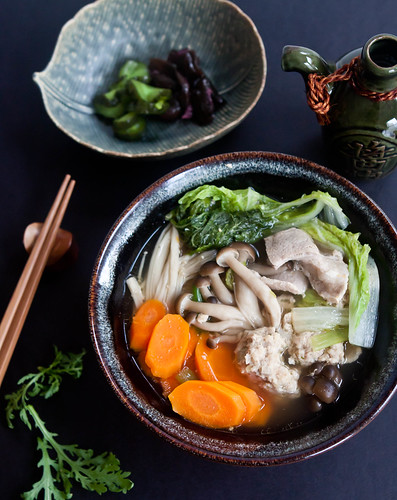
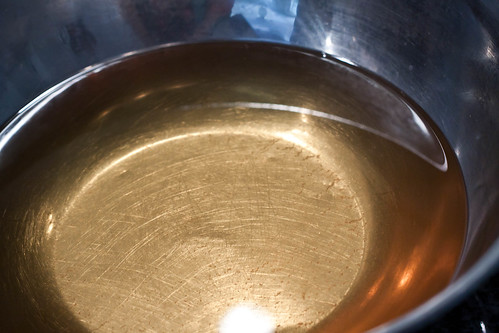
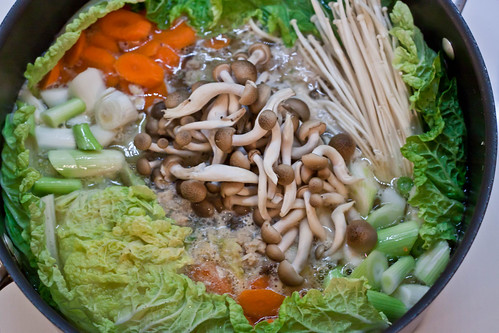
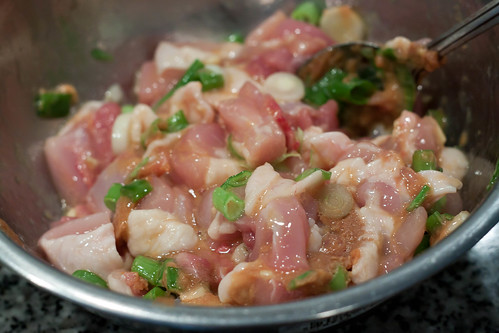

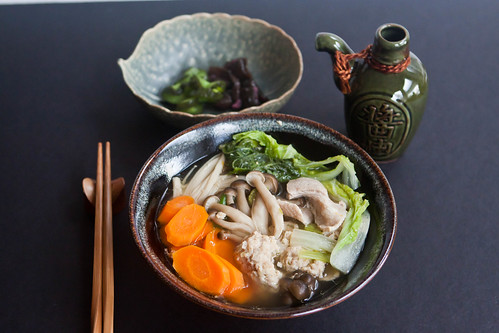
Pingback: Chanko Nabe()
Pingback: Food in Japan | japingu()